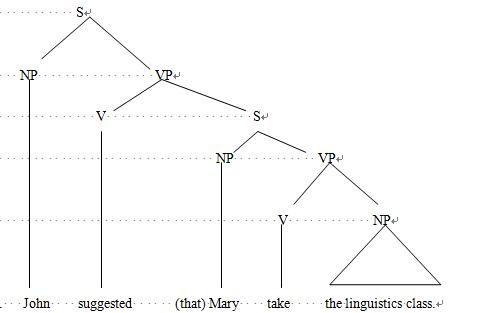
2019年00830现代语言学自考模拟试题(四)由自考生网为考生们提供整理。
注:不同省份、不同专业的自考模拟试题,只要课程代码和课程名称相同,都可参考使用。
2019年00830现代语言学自考模拟试题(四)
一、单项选择 (1--- 5ABCBD 6---10CCBCB 11---15BDAAD)
1. Which of the following sounds is a voiceless bilabial stop?
A. [p]
B. [b]
C. [m]
D. [t]
2. The great source of modification of the air stream is found in the ______ cavity.
A. nasal
B. oral
C. lung
D. glottis
3. ______ act is the act performed by or resulting from saying something.
A. A locutionary B. An illocutionary
C. A perlocutionary D. A speech
4. Once the notion of ______ was taken into consideration, semantics spilled into pragmatics.
A. meaning
B. context
C. form
D. content
5. Sense is concerned with the ______ meaning of the linguistic form.
A. contextual
B. real
C. behaviorist
D. inherent
6. Hyponyms of the same ______ are co-hyponyms.
A. word
B. lexical item
C. superordinate
D. hyponym
7. Words that are opposite in meaning are ______.
A. synonyms
B. hyponyms
C. antonyms
D. homophones
8. The word “modernizers” is composed of _____ morphemes.
A. 3
B. 4
C. 5
D. 6
9. According to F. de Saussure, _____ refers to the abstract linguistic system shared by all the members of a speech community.
A. parole
B. performance
C. langue
D. language
10. Language is arbitrary in that there is no logical connection between meanings and ______.
A. words
B. sounds
C. objects
D. ideas
11. ______ morphemes are those that cannot be used independently but have to be combined with other morphemes, either free or bound, to form a word.
A. Free
B. Bound
C. Root
D. Affix
12. The smallest meaningful unit of language is ______.
A. root
B. affix
C. stem
D. morpheme
13. _____ refers to a word or expression that is prohibited by the “polite” society from general use.
A. Linguistic taboo
B. Euphemism
C. Address term
D. Slang
14. Lying under the skull, the human brain contains an average of the ten billion nerve cells called ______.
A. neurons
B. nerve system
C. nerves
D. cerebral cortex
15. ______ language belongs to the Sino-Tibetan Family.
A. English
B. Spanish
C. Indian
D. Chinese
二、名词解释 (每个2分,共20 分)
1. Linguistics is generally defined as the scientific study of language.
2. Morphology is a branch of grammar which studies the internal structure of words and the rules by which words are formed.
3. Reference means what a linguistic form refers to in the real physical world; it deals with the relationship between the linguistic element and the non-linguistic world of experience.
4. An illocutionary act is the act of expressing the speaker’s intention; it is the act performing is saying something.
5. Speech community is thus defined as a group of people who form a community (which may have few members as a family or as many members as a country), and share the same language or a particular variety of language.
6. Language is a system of arbitrary vocal symbols used for human communication.
7. Inflectional affixes or inflectional morphemes manifest various grammatical relations or grammatical categories such as number, tense, degree, and case.
8. Pragmatics is the study of how speakers of language use sentences to effect successful communication.
9. Accent refers to a way of pronunciation which tells the listener something about the speaker’s regional or social background.
10. A lingua franca is a variety of language that serves as a medium of communication among groups of people from diverse linguistic backgrounds.
三、简答题(每小题5分,共20分)
1. What is the distinction between competence and performance?
Competence and performance was proposed by the American linguist N. Chomsky in the late 1950’s. Chomsky defines competence as the ideal user’s knowledge of the rules of his language, and performance the actual realization of this knowledge in linguistic communication.
2. What are the sense relations between sentences?
Sense relations between sentences:
1) X is synonymous with Y.
2) X is inconsistent with Y.
3) X entails Y.(Y is an entailment of X.)
4) X presupposes Y. (Y is a prerequisite of X)
5) X is a contradiction.
6) X is semantically anomalous.
3. What is idiolect?
When an individual speaks, what is actually produced is a unique language system of the speaker, expressed within the overall system of a particular language. Such a personal dialect is referred to as idiolect.
4. What is the Sapir-Whorf hypothesis?
Sapir-Whorf proposed first that all higher levels of thinking are dependent on language. Or put it more bluntly, language determines thought, hence the strong notion of linguistic determinism. Because languages differ in many ways, Whorf also believed that speakers of different languages perceive and experience the world differently, that is, relative to their linguistic background, hence the notion of linguistic relativism. In short, the strong version of the Sapir-Whorf hypothesis proposes that the language we speak determines the way we perceive the world and therefore the nature of thought.
四、 论述题(每小题10分,共30分)
1. What are the design features of language?
Design features refer to the defining properties of human language that distinguish it from any animal system of communication.
1) arbitrariness
2) productivity
3) duality
4) displacement
5) cultural transmission
2. Draw a labeled constituent structure tree diagram for each of the following sentences:
1) The student likes the new linguistics professor.
2) John suggested Mary take the linguistics class.
1. The student likes the new linguistics professor.
2. John suggested (that) Mary take the linguistics class.

3. What is the difference between acquisition and learning? Illustrate with examples.

Acquisition refers to the gradual and subconscious development of ability in the first language by using it naturally in daily communicative situations. Learning, however, is defined as a conscious process of accumulating knowledge of a second language usually obtained in school settings. It is recognized that children acquire their native language without explicit learning. A second language is more commonly learned but to some degree may also be acquired, depending on the environmental setting and the input received by the L2 learner.
以上“2019年00830现代语言学自考模拟试题(四)”由自考生网www.zikaosw.cn收集、提供。更多模拟试题资料可查看我办“模拟试题”栏目。
全专业电子资料、题库、学位、网课
最高直省2344元
上千+科次精品网课
买网课即送全真模考题库
五千+科次教材资料
电子资料满三件9折
五千+科次在线题库
全真呈现历年考试试题